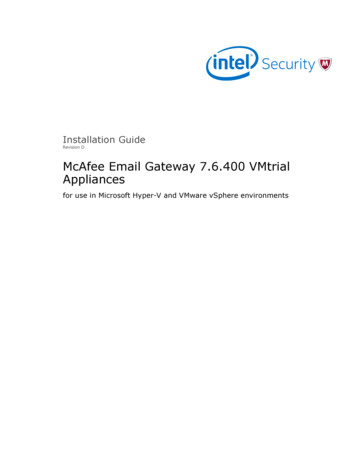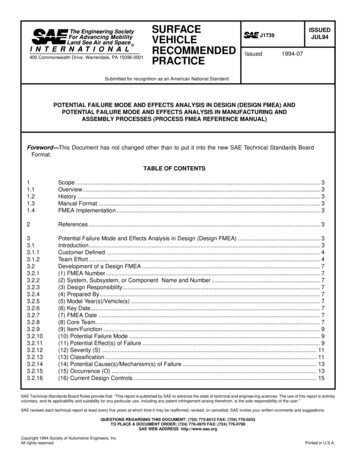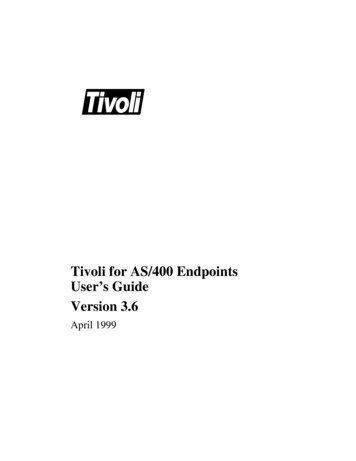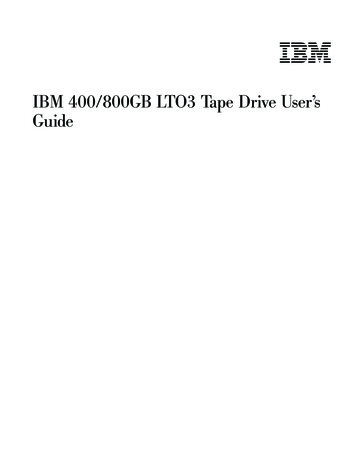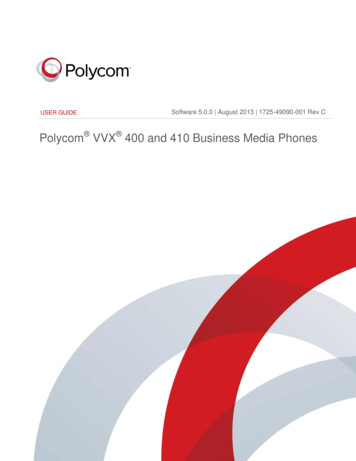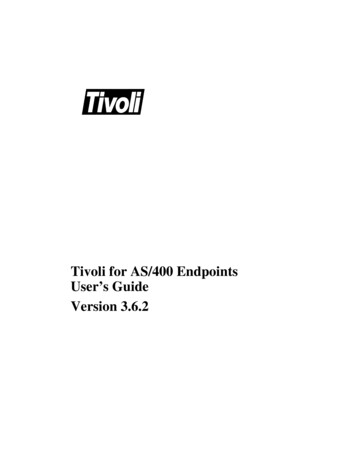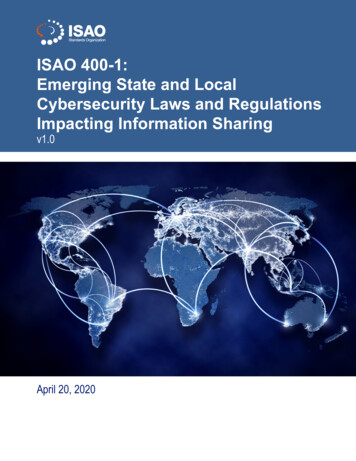
Transcription
ISAO 400-1:Emerging State and LocalCybersecurity Laws and RegulationsImpacting Information Sharingv1.0April 20, 2020
ISAO SO 400-1Emerging State and Local Cybersecurity Lawsand Regulations Impacting Information SharingVersion 1.0ISAO Standards OrganizationApril 20, 2020i
Copyright 2020, ISAO SO (Information Sharing and Analysis Organization StandardsOrganization). Any part of this publication may be distributed, posted, reproduced,stored in a retrieval system, or transmitted in any form or by any means without the priorwritten permission of the copyright owner.ii
AcknowledgementsThis publication was developed by the Information Sharing and Analysis Organization StandardsOrganization (ISAO SO) with representatives from the private, professional, and governmentcommunities in an ongoing effort to produce a unified voluntary set of guidelines for informationsharing. The ISAO SO and the Working Group leadership are listed below.ISAO Standards OrganizationGregory B. White, Ph.D.ISAO SO - Executive DirectorDirector, UTSA Center for Infrastructure Assurance and SecurityJeremy J. WestISAO SO – Director of Lifecycle DevelopmentUTSA Center for Infrastructure Assurance and SecurityWorking Group Four— Privacy and SecurityDavid TuretskyNorma KrayemCarl AndersonProfessor of PracticeSr. Policy Advisor & ChairChief Legal OfficerUniversity of AlbanyHolland & Knight LLPHITRUSTThe ISAO SO leadership and authors of this document would also like to acknowledge thoseindividuals who contributed significantly to the development of this publication, including:Stuart Gerson, Carl Anderson, Betsi McGrath, Suzanne Rutkoski, Meagan Stifle, Jay Taylor, andPatrick O’Brien.Special thanks from the working group members and the ISAO SO to Elizabeth Doerr for herresearch and essential contribution to this document. The authors would also like to thank theISAO SO advisors and staff who provided support and guidance in the development of thisdocument: Julina Macy and Allen Screffler.iii
ISAO SO 400-1 Emerging State and Local Cybersecurity Laws andRegulations Impacting Information SharingTable of Contents1Executive Summary State Laws 62State Laws 82.1GDPR as an influence on the States 82.2Incentives 112.3General Legislation Can Be of Relevance 132.1.13Local Laws 143.14Information Sharing Officers 10Geographical Sharing 15Conclusion 16Appendix A - Glossary 17Appendix B - Acronyms 21iv
ISAO SO 400-1 Emerging State and Local Cybersecurity Laws andRegulations Impacting Information SharingRevision UpdatesItemVersionDescriptionDateV 0.5RFC Version 0.515 November, 2019V. 0.7Final Review13 April, 2020V 1.0Final Published Version20 April, 2020v
ISAO SO 400-1 Emerging State and Local Cybersecurity Laws andRegulations Impacting Information Sharing1 EXECUTIVE SUMMARY STATE LAWSAn Information Sharing and Analysis Organization (ISAO) is any group of individuals ororganizations established for purposes of collecting, analyzing and disseminating cyberor relevant information in order to prevent, detect, mitigate, and recover from risks,events or incidents against the confidentiality, integrity, availability and reliability ofinformation and systems. 1Information Sharing and Analysis Centers (ISACs), a type of ISAO, provide centralresources for gathering information on cyber threats. Historically, many ISACs havefocused on critical infrastructure sectors. ISAOs may share information exclusively inone sector, among similar sectors, or between the private and public sectors.ISAOs and similar organizations can be a critical resource in providing cyber threatinformation (CTI) and deterrence and resilience support to states and localities. Inconnection with such activities, parties must be aware of the fact that state and locallaws have the potential to affect both service and compliance.The relevance and applicability of these laws varies based on the terms of the law andthe promulgating jurisdiction’s reach. Relevance and applicability will also vary based onthe location of an ISAO, the nature and experience of its members, and the manner inwhich the ISAO operates. The content of these state and local laws might discourage orencourage information sharing, or otherwise influence ISAOs operational choices. It isimportant, therefore, for an ISAO to understand what types of state and local laws mightbe relevant to their general operations, and to take steps to become aware of thespecific provisions of such laws and any incentives or restrictions that they impose. Inthat this is a dynamic field, such provisions also should be monitored periodically. Forthese reasons ISAOs should conduct active research and consider contributing,consistent with their resources, to the writing or revision of any legislation or regulationthat directly or indirectly affects their specific area of focus. This could help ensurelegislation is effective, has no unintended impacts, and also may educate the legislatorsabout their needs.It is generally understood that ISAOs are established to collect and share various formsof threat vector and cybersecurity risk information, along with compliance and othereffective practices. This type of information could include intelligence about such thingsas breaches, hacks, exploits and vulnerabilities, but generally not Personally IdentifiableInformation (“PII”), or information that can be used to identify specific individuals, suchas Social Security numbers, addresses, or drivers’ license data. Often, much of anISAOs’ attention to legal and policy developments, pertaining to information sharing,has understandably been drawn to the federal and international levels. At the federallevel, attention has often focused on Executive Orders relevant to information sharing1ISAO SO (nd). Frequently Asked Questions. https://www.isao.org/faq/ retrieved October 30, 2019.6
ISAO SO 400-1 Emerging State and Local Cybersecurity Laws andRegulations Impacting Information Sharingsuch as Executive Order 13691, Promoting Private Sector Cybersecurity InformationSharing (February 13, 2015) and on the passage and implementation of, and continuingdevelopments related to, the 2015 Cybersecurity Information Sharing Act (“CISA”).Since becoming law, CISA has generated public comment and discussion, and hasundergone various phases of implementation and refinement in its administration. 2Internationally, much of the focus has been on the strong privacy laws beingimplemented in Europe and elsewhere, particularly the European Union’s General DataProtection Regulation (GDPR). 3There has been far less focus on how state and local laws, or proposals directly orindirectly, affect ISAOs. Even if there is no direct or indirect effect, they might still be ofrelevance and may inhibit or encourage information sharing or create additionalopportunities for ISAOs.ISAOs and others have been compelled by developments, however, to focus attentionon state and local legislation and regulation, particularly with respect to thecommunication and retention of PII. Every state and territory now has a law governingbreach notification and there is significant variance among them. Thus, breach subjectreporting requirements aside, the sorts of information that a state or locality mightbenefit receiving from or sharing with an ISAO can also vary.Of increasing significance at the sub-Federal level is the fact that a number of stateshave enacted, or are considering, legislation modeled upon the GDPR. Chief amongthese is California’s Consumer Privacy Act, which became effective January 1, 2020.Nevada has passed a similar law and Illinois has promulgated a privacy statute focusingon biometric data. Although the terms of emergent state and local law is yet to bedetermined, the importance of this evolving legal array is highly significant. Forexample, some states are considering, or are in the process of passing andimplementing, laws that pertain to Personally Identifiable Information (PII). Althoughthese laws have not defined PII at this time, most ISAOs intend to and successfullyavoid collecting any such PII, other than about their own employees.The Cybersecurity Information Sharing Act (CISA) is a federal law designed to improve cybersecurity in theUnited States through enhanced sharing of information about cybersecurity ss/senate-bill/7543GDPR is a European Union (EU) regulation on data protection and privacy, protecting all individuals within theEU. Its reach further includes citizens of other countries (such as the United States) who share their personalinformation with European businesses or potentially even businesses operating from abroad who gather informationfrom those in the EU. GDPR came into effect May 25, 2018 and violations carry potentially severe penalties.Generally, the GDPR requires that companies be transparent about what personal data they are collecting, what theyare using customer’s data for, with whom they are sharing it, allows customers to access and make certain decisionsabout personal data pertaining to them, and emphasizes the need to obtain consent before using data or disclosing itto a third party and to allow persons the right to be “forgotten.” While a matter of importance to many Americancompanies, the significance to ISAO members lies in the fact that much of developing U.S. law is being modeledupon the GDPR.27
ISAO SO 400-1 Emerging State and Local Cybersecurity Laws andRegulations Impacting Information SharingA number of states are looking to provide incentives for entities to engage in voluntaryinformation sharing, as CISA sought to do at the federal level. Finally, some cities andother jurisdictions are beginning to develop sharing centers or “hubs,” which collect,share, and disseminate information. See, for example, Section 3 below (discussion ofNew York City). These sharing centers could become resources for ISAOs to takeadvantage of and help them better serve their members. In view of the fact that somestate and city offices have been subject to hacks and exploits that have interruptedvarious services and facilities and others have been forced to succumb to costlyransomware demands, the desire for cooperative efforts involving ISAOs ought to beincreasing.The following sections highlight examples of legislative developments for ISAOs toconsider. It is not intended to be comprehensive, exhaustive, or to provide legal advice.As previously mentioned, information reporting and sharing is a dynamic and changingenvironment which any entity must monitor.2 STATE LAWSAs noted above, many state and local legislators, as well as regulators and otherstakeholders, have used the laws of other nations as models in implementing strongprivacy legislation. The California Consumer Privacy Act is a prime example of thisactivity, but as noted, every state and U.S. territory has laws and regulations governingdata breaches.2.1 GDPR AS AN INFLUENCE ON THE STATESMany state laws focus on privacy rights and not information sharing. The wideapplicability of these laws affect and can be applied to any entity that acquires or sharesPII. This may be relevant to an ISAO in its capacity as an employer or recipient ofcertain financial information, but it can also be relevant to an ISAO if it receives personaldata from its members, perhaps for sharing. That being said, ISAOs typically do notintend to, nor do they, collect personal data or PII for sharing (since it typically is notnecessary to satisfy their purposes). In the event, however, that an ISAO does collectpersonal information or data about its employees or about individuals related to itsmembers, it is critical that it be aware of and consider these privacy laws.As is mentioned above, the prime, though far from the only, example of emergent statelaw is California’s privacy law originally passed in 2018. It is known as the CaliforniaConsumer Privacy Act of 2018 and is sometimes referred to as the CCPA or even as“GDPR Lite.” 4 The law’s purpose is to “ ensure the privacy of Californians’ personalinformation through various consumer rights. Consumer rights established includeKari Paul. (December 30, 2019 Monday). California's groundbreaking privacy law takes effect in January. Whatdoes it do? The Guardian. lifornia-consumer-privacy-actwhat-does-it-do48
ISAO SO 400-1 Emerging State and Local Cybersecurity Laws andRegulations Impacting Information Sharingthe right to know whether a person’s personal information is being collected andwhether it is being sold; the right to have businesses delete a person’s personalinformation; the right to opt-out of or opt-in to the sale of a person’s personalinformation.”5 The breach of any of these provisions could result in a business beingrequired to pay damages to a customer whose rights are violated, injunctive ordeclaratory relief, or other damages the court deems proper. 6 The Act was introducedand passed quickly to derail a citizens’ ballot initiative that many in industry thoughtcould be even more onerous that otherwise would have been included on California’sNovember 2018 election ballot. The sponsors of the ballot initiative agreed to take astep back if the legislation was passed. 7 This does not necessarily preclude future ballotinitiatives after implementation of the CCPA.There have been numerous proposals in other states to take on some of the samesubjects as the California privacy law. Nevada, as noted, followed suit. In July 2019,New York passed the Stop Hacks and Improve Electronic Data Security Act (SHIELDAct), which expands the definition of PII for New York residents to include biometricdata, username or email address in combination of password or security questions, andaccount numbers, credit or debit card, if they can be used exclusively to accessaccounts. 8 In the past, there has been uncertainty if exfiltration of PII or accessing thedata constitutes a breach. In the case of ransomware, some attackers only access thedata without acquiring it. Under the SHIELD Act, New York joins a few other states thatconsider having access to the data as constituting a breach. 9 As of October 23, 2019,the expanded definition of PII took effect and the law requires notification of impactedresidents, state, regulators, and under certain conditions consumer reportingagencies. 10 In addition, businesses are still required to notify the New York AttorneyGeneral, New York Secretary of State, and the Division of the State Police in the caseof a breach.In several states, legislation often requires that breach notification be provided to thestate attorney general and specifies notification timetables, available fines, etc. A courtmay also impose penalties on a business in addition to the payment of attorney’s fees ifthe customer prevails in their suit.See: California Consumer Privacy Act of 2018. Assembly Committee on Appropriations, Lorena GonzalezFletcher, chair. SB 112. Date of Hearing August 29, 2019.56See § 1798.150 of the California Consumer Privacy means.html8See: ldact/9See: ee: nrequirements/79
ISAO SO 400-1 Emerging State and Local Cybersecurity Laws andRegulations Impacting Information SharingSome of these emergent state laws allow for private rights of action without anycompliance safe harbor and, often, without the need for plaintiffs to show economic lossor other material damages. The SHIELD Act does not provide a private action, insteadthe state attorney general may bring actions to enjoin violations and obtain civilpenalties. 11While these laws do not single out ISAOs or information sharing specifically, they areimportant to note. They represent a baseline of actual or potential state privacylegislation that ISAOs should be aware of as more states are considering or areimplementing similar privacy laws of general applicability. By understanding what aparticular state’s privacy law says and being aware of the repercussions for violations,ISAOs will have an additional reason to avoid collecting such personal data. In theevent ISAOs do collect any such data, they need to maintain an active complianceprogram to prevent unauthorized disclosures and avoid legal liability. This need ismagnified if ISAO members operate in multiple states or internationally. And, if an ISAOdecides that it somehow needs to gather and potentially disseminate PII, it shouldconsider purchasing cyber risk insurance.2.1.1INFORMATION SHARING OFFICERSGDPR has not only influenced state privacy laws, but its influence can also be seen inchanges to the roles of certain state officers, such as state Chief Information Officers(CIOs). GDPR defines the role of Data Protection Officers (DPOs) and mandates thatthey be heavily involved in data collection and dissemination of information. CIOs areincreasingly expanding their responsibilities in some of these areas. 12 Aspects of aDPO’s role (such as being a business’s single point of contact who is responsible forevery stage of data collection) will likely be absorbed into the responsibilities and jobdescriptions of CIOs in some states. 13 This may give more state CIOs a clear role ininformation sharing. In turn, this can create opportunities for ISAOs to partner withstates to provide and receive more information for the benefit of members as well asprovide insight into how states view information sharing best practices and concerns.The state of Oregon, for example, is in the process of creating its own “CybersecurityCenter for Excellence,” which will act as a ISAC. 14 The state CIO’s job within theSee: icter-data-cybersecurity-laws/The role of state chief information officers is not a new idea in the United States. In fact, its prevalence led tocreation of the National Association of State Chief Information Officers (“NASCIO”) in 1969 (see:https://www.nascio.org/). Later, state chief information security officers (CISOs) became more prevalent too, andthey often are included in NASCIO. Increasingly, however, new state laws are creating additional responsibilitiesfor CIOs.111213Section 4, Article 37 of GDPR describes the role of DPOs. This officer is the single point of contact within abusiness or an organization involved with data processing tasks. Many CIOs will take on this Final%20Draft.pdf10
ISAO SO 400-1 Emerging State and Local Cybersecurity Laws andRegulations Impacting Information SharingCybersecurity Center for Excellence entails coordinating information sharing relating toany cybersecurity risks. The CIO will further act as a liaison with the NationalCybersecurity and Communications Integration Center (NCCIC) in the United StatesDepartment of Homeland Security, as well as other federal agencies, and other publicand private entities.Once the CIO receives any relevant information, including threat information, he or shemay disseminate the information to the appropriate sources including other ISAOs orISACs, Multi-State ISAC (MS-ISAC), the federal government, law enforcementagencies, public utilities, and private industry.The changing roles of state CIOs concerning information sharing and privacy, as seenin Oregon, may be useful for ISAOs to monitor and learn about. The broadening of stateCIO roles may create opportunities and precedents.2.2 INCENTIVESSome states have realized the importance of information sharing with, in addition to thefederal government, their own state entities. This has led some state governments tocreate incentives through legislation to encourage information sharing. Among suchincentives are “safe harbors” that can insulate a defendant from some or all liability inenforcement actions or litigation. ISAOs promote information sharing by working withprivate and often public sector stakeholders to create best practices and share cyberthreat information on a voluntary basis. 15 State laws do not usually mandate thatcompanies participate in information sharing with ISAOs, but ISAOs can potentially usestate support as another mechanism to promote the services that ISAOs can provide.For example, Ohio enacted Senate Bill 220, also known as the Ohio Data Protection Act(DPA) 16, which took effect in November 2018. This law’s purpose is to “provide a legalsafe harbor to covered entities that implement and maintain a specified cybersecurityprogram.” 17 The law states:Sec. 1354.02. (A) A covered entity seeking an affirmative defense under sections 1354.01to 1354.05 of the Revised Code shall do one of the following: (1) Create, maintain, andcomply with a written cybersecurity program that contains administrative, technical, and15See: https://www.isao.org/about/See: ection-act-27275/A “covered entity” under this statute includes any business that accesses, maintains, communicates, or processespersonal information or restricted information in or through one or more systems, networks, or services located in oroutside this state. See full Bill Text here: lationsummary?id GA132-SB-220161711
ISAO SO 400-1 Emerging State and Local Cybersecurity Laws andRegulations Impacting Information Sharingphysical safeguards for the protection of personal information and that reasonablyconforms to an industry recognized cybersecurity framework, as described in section1354.03 of the Revised Code; or (2) Create, maintain, and comply with a writtencybersecurity program that contains administrative, technical, and physical safeguards forthe protection of both personal information and restricted information and that reasonablyconforms to an industry recognized cybersecurity framework, as described in section1354.03 of the Revised Code. (B) A covered entity's cybersecurity program shall bedesigned to do all of the following with respect to the information described in division(A)(1) or (2) of this section, as applicable : (1) Protect the security and confidentiality ofthe information; (2) Protect against any anticipated threats or hazards to the security orintegrity of the information; (3) Protect against unauthorized access to and acquisition ofthe information that is likely to result in a material risk of identity theft or other fraud tothe individual to whom the information relates. 18In essence, under the Ohio law, the businesses who choose to implement writtencybersecurity programs and best practices may claim an affirmative defense that canfree them from liability if there is a breach in their system and customer PII iscompromised. DPA is intended to provide an incentive to encourage businesses toachieve a higher level of cybersecurity through voluntary action. 19 DPA does not, nor isit intended to, create minimum cybersecurity standards that must be achieved, 20 norshould it be read to impose liability upon businesses. New York’s SHIELD Act containssimilar compliance provisions as DPA; however, it does not provide an “expressedaffirmative defense against state tort actions for entities with compliance informationsecurity programs.”21This Ohio law does not require companies to participate in information sharing.However, the possibility of additional liability protections may sway some companies todecide to participate. ISAOs could consider reaching out to companies who fall withinSee: lation-summary?id GA132-SB-220The affirmative defense is to a cause of action sounding in tort (negligence, invasion of privacy, etc.), includingallegations of a data breach resulting from a failure to implement reasonable information security controls.20In addition to certain initiatives like Ohio’s legal safe harbor law, there are other state initiatives that may besector specific. New York’s financial institution’s cybersecurity law is a prime example. Beginning September 4,2018; banks, insurance companies, and other financial service institutions that are regulated by DFS are required tobe in compliance with new provisions of cybersecurity regulations. These provisions require a covered entity toestablish written incident response plans, comply with breach notification policies, have policies in place concerningthe disclosure of information to third parties, and comply with data retention policies. See more m181921See: icter-data-cybersecurity-laws/12
ISAO SO 400-1 Emerging State and Local Cybersecurity Laws andRegulations Impacting Information Sharingthe definition of a covered entity and invite and encourage new members to join byusing the additional liability protections provided by the bill as an incentive. Companiesmay see these additional liability protections as reason to engage in information sharingand as a potentially valuable addition to written cybersecurity plans or policies, therebyshowing the state that they are taking important and valuable steps to guard againstdata or privacy breaches.Additionally, ISAOs located within Ohio might want to consider whether they also wishto have written cyber policies and measures in place, thereby allowing an ISAO itself toqualify for the affirmative defense. By having these policies and programs, the ISAOmight have an additional defense available if ever needed in an Ohio action againstthem.2.3 GENERAL LEGISLATION CAN BE OF RELEVANCESometimes an ISAO may need to look particularly closely at the jurisdictions mostrelevant to it to uncover relevant laws or developments. Potentially relevant provisionsmay be buried in laws with a purpose broader than cybersecurity or privacy.An example is Virginia’s Budget Bill (Bill 50002, enacted June 2018). This bill includes aprovision that provides funding to state police to develop and operate cybersecurity andmanagement tools to address any risks, threats, and/or vulnerabilities to data that areoutside of the scope of their memorandum of understanding (MOU) with the VirginiaInformation Technologies Agency (VITA). The state police collect this information andreport it to VITA, who in turn actively participates with and shares information with theMulti-State Information Sharing and Analysis Center (MS-ISAC). 22Furthermore, several states have implemented general laws that protect criticalinfrastructure as well as the PII of their citizens. 23 The texts of these laws guide stateentities to follow Emergency Response Plans (EPRs) which have already beenimplemented. These governmentally mandated regimes typically require theircomponents to detail training and set forth Business Continuity Plans (BCPs) or IncidentResponse Plans (IRPs) specifically written to address data breaches, including whoaffected entities should report to, when they should report, how the information shouldVirginia Information Technology Agency is Virginia’s consolidated information technology organization. TheCommonwealth Security and Risk Management (CSRM) COV Security Outreach & Information Sharing Teamactively participates with MS-ISAC, Local, State (VA Fusion Center and Commonwealth Preparedness WorkingGroup), and Federal Law Enforcement (FBI), and multiple Commonwealth of Virginia Information/InfrastructureSecurity groups.23States that have begun enacting broader legislation include, but are not limited to: Arkansas (regarding emergencypowers of bank commissioner, relating to cyberattacks and cybersecurity breaches); Colorado (this law concerns theauthority of the Joint Technology Committee; regarding data privacy and cybersecurity within state agencies andmay coordinate with the Colorado cybersecurity committee), Maryland (making proposed appropriations within thestate Budget Bill). See more at: 2017.aspx2213
ISAO SO 400-1 Emerging State and Local Cybersecurity Laws andRegulations Impacting Information Sharingbe reported, etc. The state of Iowa, for example, not only has a state level informationsecurity office, but also reports any data breaches to MS-ISAC. As noted, the breachnotification laws of all 50 states and U.S. territories vary significantly among themselves,but all impose on private data holder’s notification and response requirements. Theselaws provide guidance with respect to reporting and, in some cases, best practices.Generally, most ISAOs will have no need for sharing PII and do not do so. ISAOsshould consider obtaining additional guidance on relevant state statutes andregulations, highlighting private or state entities who receive funding to performcybersecurity related activities. These laws may open the door for ISAOs to help identifyand serve potential recipients who might wish to participate in sharing and becomingISAO members.3 LOCAL LAWSMunicipalities typically have not chosen to implement local laws
Apr 20, 2020 · The ISAO SO leadership and authors of this document would also like to acknowledge those . Appendix A - Glossary _ 17 Appendix B - Acronyms _ 21 . Many state laws focu
